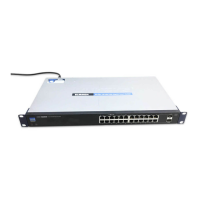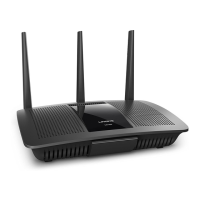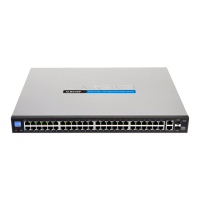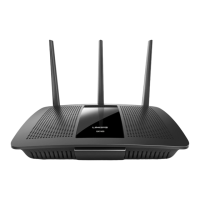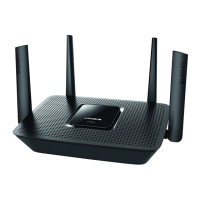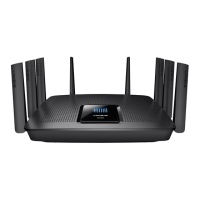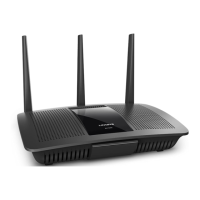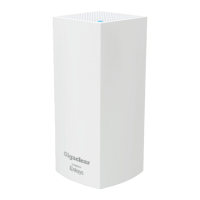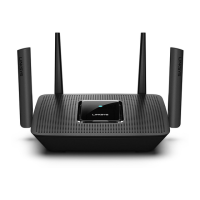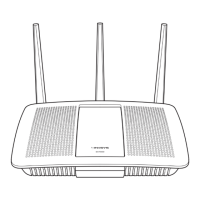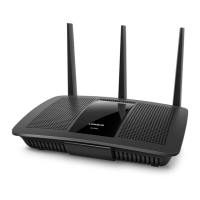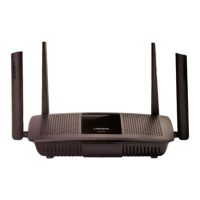Do you have a question about the Linksys SRW2008MP and is the answer not in the manual?
Provides an introduction to the user guide and the product models covered.
Details the front panel components, LEDs, and ports for the SRW2008 model.
Details the front panel components, LEDs, and ports for SRW2008P/SRW2008MP models.
Describes the mini-GBIC ports for connecting expansion modules and high-speed networks.
Explains the console port for connecting a PC for initial configuration via serial cable.
Details the console and power ports located on the back panel of the switch.
Provides an overview of connecting network devices to the switch and a typical network configuration.
Instructions for placing the switch on a desktop for optimal ventilation and accessibility.
Guidelines and steps for securely mounting the switch in a standard 19-inch rack.
Instructions for horizontally mounting the switch on a wall using provided template and screws.
Step-by-step instructions for connecting network devices, power cords, and console cables.
Introduces console interface configuration and telnet connections for switch management.
Step-by-step guide on setting up HyperTerminal for console access to the switch.
Instructions for establishing a Telnet connection to the switch's command-line interface.
Explains navigation and interaction with the switch's console interface menus.
Describes the main menu options available in the console interface for switch management.
Details how to view the switch's Boot, Software, and Hardware versions.
Covers configuration options for Serial Port, Telnet, and SSH sessions.
Explains how to configure the serial port's baud rate for console communication.
Details how to configure the Telnet session timeout setting.
Covers SSH server configuration, status, and key generation options.
Instructions for administering user names and passwords for switch access.
Explains how to configure security settings and generate SSL certificates.
Details how to configure the switch's IP address, subnet mask, and gateway.
Explains how to configure the status and port number of the HTTP server.
Details how to enable or disable the HTTPS server and configure its port.
Provides options for running network tests like Ping and TraceRoute.
Covers uploading or downloading configuration, boot, or image files via TFTP.
Displays the current status, link, speed, and duplex mode of each switch port.
Explains how to configure individual port settings such as speed, duplex, and auto-negotiation.
Provides access to help information for navigating the console interface.
Introduces the features available in the Web-based Utility for advanced configuration.
Instructions for accessing the switch's web-based management interface via a web browser.
Displays device and system information about the switch.
Shows details like System Name, IP Address, Subnet Mask, and DNS Servers.
Provides Serial Number, Model Name, Hardware and Boot versions.
Displays information related to Power over Ethernet (PoE) capabilities and usage.
Allows configuration of DHCP or static IP settings and default gateways.
Fields for assigning a system name, location, and contact person.
Covers IP address settings, HTTP, HTTPS, and Network configuration.
Allows configuration of the primary DNS Server information.
Enables configuration of the switch's time settings using system or SNTP time.
Options for setting the system time manually using local hardware clock.
Allows manual entry of Hours, Minutes, Seconds, Month, Day, and Year.
Configuration options for enabling and setting daylight saving time.
Allows configuration of primary and secondary SNTP servers for time synchronization.
Displays and allows configuration of settings for each of the switch's ports.
Provides detailed configuration parameters for individual switch ports.
Allows modification of port parameters like type, admin status, speed, and duplex.
Covers configuration and management of Link Aggregation Groups (LAGs).
Details Link Aggregation Control Protocol (LACP) settings for automatic link aggregation.
Allows configuration of Power over Ethernet (PoE) settings for ports.
Provides options for creating and configuring Virtual LANs (VLANs).
Displays a list of all configured VLANs, their IDs, names, and status.
Allows assignment of ports to VLANs and configuration of port modes (General, Access, Trunk).
Configures port membership and PVID settings for VLAN assignment.
Assigns VLANs to specific interfaces and defines port modes.
Specifies VLAN membership and tagging status for selected ports.
Covers GARP VLAN Registration Protocol for automatic VLAN distribution.
Displays device utilization and error statistics for traffic management.
Shows historical data samples for ports, including interface definitions and polling periods.
Allows setting network alarms based on thresholds for detected network problems.
Provides information on EAP packets received on specific ports for authentication.
Displays device statistics related to the GVRP protocol.
Defines Access Control Lists (ACLs) based on IP addresses and protocols.
Allows the definition of Access Control Lists (ACLs) based on MAC addresses.
Binds defined ACLs to specific interfaces, applying rules to network traffic.
Configuration for Remote Authorization Dial-In User Service (RADIUS) for network authentication.
Configuration for Terminal Access Controller Access Control System (TACACS+) for centralized security.
Enables port-based authentication using RADIUS and EAP for network access control.
Limits port access to specific MAC addresses for enhanced network security.
Configures advanced port-based authentication settings for multiple hosts.
Provides mechanisms to limit broadcast, multicast, and unicast traffic to prevent network storms.
Enables or disables Class of Service (CoS) and configures trust modes.
Defines QoS queue forwarding types and traffic scheduling methods.
Maps Differentiated Services Code Point (DSCP) values to specific queues.
Allows network managers to define bandwidth settings for egress interfaces.
Configures basic QoS settings, including trust mode and mapping of CoS/DSCP tags.
Provides rules for flow classification and assigning actions for bandwidth management.
Displays DSCP values and allows selection of new DSCP out values.
Defines new policy names and selects existing policies for QoS configuration.
Creates new Class Maps for matching packet criteria and defining QoS policies.
Allows creation of aggregate policers for traffic policing purposes.
Displays the current Spanning Tree Protocol (STP) status on the device.
Configures global STP parameters, including state, operation mode, and BPDU handling.
Assigns STP settings to specific interfaces, including port state and path cost.
Details Rapid Spanning Tree Protocol (RSTP) port settings for faster convergence.
Configures Multiple Spanning Tree Protocol (MSTP) properties like region names and revisions.
Maps VLANs to STP instances and defines instance-specific parameters.
Assigns MSTP interface settings, including instance ID, port state, and role.
Enables and configures IGMP Snooping to optimize multicast traffic delivery.
Manages multicast service groups, assigning ports and LAGs to specific groups.
Attaches ports or LAGs to devices for forwarding multicast packets.
Configures parameters for SNMP notification settings, including engine ID and notifications.
Defines SNMP views to control access to device features and aspects.
Creates SNMP groups and assigns access control privileges to specific features.
Assigns SNMP access control privileges to SNMP groups using user names and engine IDs.
Configures SNMP communities for basic and advanced management access.
Filters SNMP traps based on OIDs and allows network managers to filter notifications.
Modifies user passwords and configures authentication methods (Local, RADIUS, TACACS+).
Assigns static IP addresses to specific interfaces on the switch.
Manages the dynamic MAC address table, including querying and aging parameters.
Enables viewing and recording device events, errors, and informational messages.
Monitors and mirrors network traffic by forwarding copies of packets for analysis.
Performs performance tests on copper cables, checking for faults and length.
Allows saving the current switch configuration to a local or TFTP server.
Provides options for upgrading the switch firmware via HTTP or TFTP server.
Resets the switch, automatically saving the configuration before rebooting.
Resets the switch to its factory default settings, erasing the current configuration.
Configures and views remote log servers, defining severity levels for sent logs.
Displays system logs saved in RAM (Cache) in chronological order.
Shows log entries saved to FLASH, including time, severity, and message description.
Detailed technical specifications for the SRW2008 model, covering ports, performance, and features.
Details Quality of Service parameters including priority levels, scheduling, and class of service.
Lists the networking standards supported by the switch, such as Ethernet and PoE.
Provides environmental operating and storage specifications for the device.
Details the Linksys limited hardware warranty terms and conditions.
Outlines specific conditions under which the limited warranty does not apply.
Provides instructions and resources for obtaining technical support and warranty service.
Information on accessing Linksys' current technical support offerings and policies.
Compliance statement regarding FCC rules for Class A digital devices.
Important safety precautions for using the equipment, including electrical and environmental warnings.
Compliance statement for Class A digital apparatus according to Canadian ICES-003.
Declaration of conformity with European directives for EMC, Low Voltage, and safety standards.
Information on the proper disposal and recycling of electronic equipment according to EU directives.
Provides a list of regional web addresses for contacting Linksys support.
Provides an introduction to the user guide and the product models covered.
Details the front panel components, LEDs, and ports for the SRW2008 model.
Details the front panel components, LEDs, and ports for SRW2008P/SRW2008MP models.
Describes the mini-GBIC ports for connecting expansion modules and high-speed networks.
Explains the console port for connecting a PC for initial configuration via serial cable.
Details the console and power ports located on the back panel of the switch.
Provides an overview of connecting network devices to the switch and a typical network configuration.
Instructions for placing the switch on a desktop for optimal ventilation and accessibility.
Guidelines and steps for securely mounting the switch in a standard 19-inch rack.
Instructions for horizontally mounting the switch on a wall using provided template and screws.
Step-by-step instructions for connecting network devices, power cords, and console cables.
Introduces console interface configuration and telnet connections for switch management.
Step-by-step guide on setting up HyperTerminal for console access to the switch.
Instructions for establishing a Telnet connection to the switch's command-line interface.
Explains navigation and interaction with the switch's console interface menus.
Describes the main menu options available in the console interface for switch management.
Details how to view the switch's Boot, Software, and Hardware versions.
Covers configuration options for Serial Port, Telnet, and SSH sessions.
Explains how to configure the serial port's baud rate for console communication.
Details how to configure the Telnet session timeout setting.
Covers SSH server configuration, status, and key generation options.
Instructions for administering user names and passwords for switch access.
Explains how to configure security settings and generate SSL certificates.
Details how to configure the switch's IP address, subnet mask, and gateway.
Explains how to configure the status and port number of the HTTP server.
Details how to enable or disable the HTTPS server and configure its port.
Provides options for running network tests like Ping and TraceRoute.
Covers uploading or downloading configuration, boot, or image files via TFTP.
Displays the current status, link, speed, and duplex mode of each switch port.
Explains how to configure individual port settings such as speed, duplex, and auto-negotiation.
Provides access to help information for navigating the console interface.
Introduces the features available in the Web-based Utility for advanced configuration.
Instructions for accessing the switch's web-based management interface via a web browser.
Displays device and system information about the switch.
Shows details like System Name, IP Address, Subnet Mask, and DNS Servers.
Provides Serial Number, Model Name, Hardware and Boot versions.
Displays information related to Power over Ethernet (PoE) capabilities and usage.
Allows configuration of DHCP or static IP settings and default gateways.
Fields for assigning a system name, location, and contact person.
Covers IP address settings, HTTP, HTTPS, and Network configuration.
Allows configuration of the primary DNS Server information.
Enables configuration of the switch's time settings using system or SNTP time.
Options for setting the system time manually using local hardware clock.
Allows manual entry of Hours, Minutes, Seconds, Month, Day, and Year.
Configuration options for enabling and setting daylight saving time.
Allows configuration of primary and secondary SNTP servers for time synchronization.
Displays and allows configuration of settings for each of the switch's ports.
Provides detailed configuration parameters for individual switch ports.
Allows modification of port parameters like type, admin status, speed, and duplex.
Covers configuration and management of Link Aggregation Groups (LAGs).
Details Link Aggregation Control Protocol (LACP) settings for automatic link aggregation.
Allows configuration of Power over Ethernet (PoE) settings for ports.
Provides options for creating and configuring Virtual LANs (VLANs).
Displays a list of all configured VLANs, their IDs, names, and status.
Allows assignment of ports to VLANs and configuration of port modes (General, Access, Trunk).
Configures port membership and PVID settings for VLAN assignment.
Assigns VLANs to specific interfaces and defines port modes.
Specifies VLAN membership and tagging status for selected ports.
Covers GARP VLAN Registration Protocol for automatic VLAN distribution.
Displays device utilization and error statistics for traffic management.
Shows historical data samples for ports, including interface definitions and polling periods.
Allows setting network alarms based on thresholds for detected network problems.
Provides information on EAP packets received on specific ports for authentication.
Displays device statistics related to the GVRP protocol.
Defines Access Control Lists (ACLs) based on IP addresses and protocols.
Allows the definition of Access Control Lists (ACLs) based on MAC addresses.
Binds defined ACLs to specific interfaces, applying rules to network traffic.
Configuration for Remote Authorization Dial-In User Service (RADIUS) for network authentication.
Configuration for Terminal Access Controller Access Control System (TACACS+) for centralized security.
Enables port-based authentication using RADIUS and EAP for network access control.
Limits port access to specific MAC addresses for enhanced network security.
Configures advanced port-based authentication settings for multiple hosts.
Provides mechanisms to limit broadcast, multicast, and unicast traffic to prevent network storms.
Enables or disables Class of Service (CoS) and configures trust modes.
Defines QoS queue forwarding types and traffic scheduling methods.
Maps Differentiated Services Code Point (DSCP) values to specific queues.
Allows network managers to define bandwidth settings for egress interfaces.
Configures basic QoS settings, including trust mode and mapping of CoS/DSCP tags.
Provides rules for flow classification and assigning actions for bandwidth management.
Displays DSCP values and allows selection of new DSCP out values.
Defines new policy names and selects existing policies for QoS configuration.
Creates new Class Maps for matching packet criteria and defining QoS policies.
Allows creation of aggregate policers for traffic policing purposes.
Displays the current Spanning Tree Protocol (STP) status on the device.
Configures global STP parameters, including state, operation mode, and BPDU handling.
Assigns STP settings to specific interfaces, including port state and path cost.
Details Rapid Spanning Tree Protocol (RSTP) port settings for faster convergence.
Configures Multiple Spanning Tree Protocol (MSTP) properties like region names and revisions.
Maps VLANs to STP instances and defines instance-specific parameters.
Assigns MSTP interface settings, including instance ID, port state, and role.
Enables and configures IGMP Snooping to optimize multicast traffic delivery.
Manages multicast service groups, assigning ports and LAGs to specific groups.
Attaches ports or LAGs to devices for forwarding multicast packets.
Configures parameters for SNMP notification settings, including engine ID and notifications.
Defines SNMP views to control access to device features and aspects.
Creates SNMP groups and assigns access control privileges to specific features.
Assigns SNMP access control privileges to SNMP groups using user names and engine IDs.
Configures SNMP communities for basic and advanced management access.
Filters SNMP traps based on OIDs and allows network managers to filter notifications.
Modifies user passwords and configures authentication methods (Local, RADIUS, TACACS+).
Assigns static IP addresses to specific interfaces on the switch.
Manages the dynamic MAC address table, including querying and aging parameters.
Enables viewing and recording device events, errors, and informational messages.
Monitors and mirrors network traffic by forwarding copies of packets for analysis.
Performs performance tests on copper cables, checking for faults and length.
Allows saving the current switch configuration to a local or TFTP server.
Provides options for upgrading the switch firmware via HTTP or TFTP server.
Resets the switch, automatically saving the configuration before rebooting.
Resets the switch to its factory default settings, erasing the current configuration.
Configures and views remote log servers, defining severity levels for sent logs.
Displays system logs saved in RAM (Cache) in chronological order.
Shows log entries saved to FLASH, including time, severity, and message description.
Detailed technical specifications for the SRW2008 model, covering ports, performance, and features.
Details Quality of Service parameters including priority levels, scheduling, and class of service.
Lists the networking standards supported by the switch, such as Ethernet and PoE.
Provides environmental operating and storage specifications for the device.
Details the Linksys limited hardware warranty terms and conditions.
Outlines specific conditions under which the limited warranty does not apply.
Provides instructions and resources for obtaining technical support and warranty service.
Information on accessing Linksys' current technical support offerings and policies.
Compliance statement regarding FCC rules for Class A digital devices.
Important safety precautions for using the equipment, including electrical and environmental warnings.
Compliance statement for Class A digital apparatus according to Canadian ICES-003.
Declaration of conformity with European directives for EMC, Low Voltage, and safety standards.
Information on the proper disposal and recycling of electronic equipment according to EU directives.
Provides a list of regional web addresses for contacting Linksys support.
| Device Type | Managed Switch |
|---|---|
| Power over Ethernet (PoE) | Yes |
| MAC Address Table | 8K entries |
| VLAN Support | Yes |
| Quality of Service (QoS) | Yes |
| Operating Temperature | 32°F to 104°F (0°C to 40°C) |
| Storage Temperature | -4°F to 158°F (-20°C to 70°C) |
| Security Features | RADIUS |
| Management | Web-based, SNMP |
| Power Supply | AC 100-240V |
| Humidity | 10% to 85% non-condensing |
| Jumbo Frame Support | 9KB |
